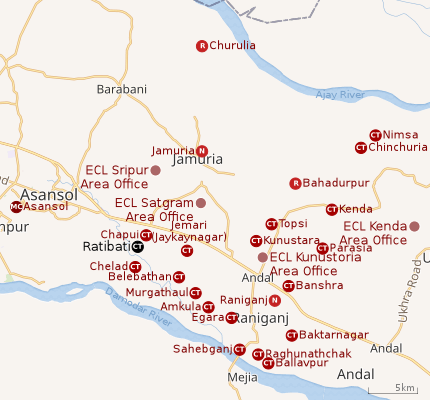Ratibati
| Ratibati | |
|---|---|
| Census Town | |
 Ratibati Location in West Bengal, India | |
| Coordinates: 23°39′15″N 87°02′24″E / 23.654125°N 87.040049°ECoordinates: 23°39′15″N 87°02′24″E / 23.654125°N 87.040049°E | |
| Country |
|
| State | West Bengal |
| District | Paschim Bardhaman |
| Population (2011) | |
| • Total | 4,508 |
| Languages | |
| • Official | Bengali, English |
| Time zone | UTC+5:30 (IST) |
| PIN | 713339 |
| Telephone code | 91 341 234 |
| Lok Sabha constituency | Asansol |
| Vidhan Sabha constituency | Jamuria |
| Website |
bardhaman |
Ratibati is a census town in Raniganj CD Block and is served by Asansol North police station in Asansol Sadar subdivision of Paschim Bardhaman district in the Indian state of West Bengal.
Geography
 |
| Cities and towns in the eastern portion of Asansol Sadar subdivision in Paschim Bardhaman district MC: Municipal Corporation, CT: census town, N: neighbourhood, R: rural centre Owing to space constraints in the small map, the actual locations in a larger map may vary slightly |
Location
Ratibati is located at 23°39′15″N 87°02′24″E / 23.654125°N 87.040049°E.
The Asansol-Durgapur area is composed of undulating laterite soil. This area lies between two mighty rivers – the Damodar and the Ajay. They flow almost parallel to each other in the region – the average distance between the two rivers is around 30 km. For ages the area was heavily forested and infested with plunderers and marauders. The discovery of coal led to industrialisation of the area and most of the forests have been cleared.[1]
Pangachhiya, Majiara, Bhanowara, Domohani, Charanpur (OG), Ratibati and Chelad form a cluster of census towns and an outgrowth on the northern and eastern sides of Asansol.[2]
Urbanisation
As per the 2011 census, 83.33% of the population of Asansol Sadar subdivision was urban and 16.67% was rural.[3]In 2015, the municipal areas of Kulti, Raniganj and Jamuria were included within the jurisdiction of Asansol Municipal Corporation.[4]Asansol Sadar subdivision has 26 (+1 partly) Census Towns.(partly presented in the map alongside; all places marked on the map are linked in the full-screen map).
Demographics
As per 2011 Census of India Ratibati had a total population of 4,508 of which 2,348 (52%) were males and 2,160 (48%) were females. Population below 6 years was 542. The total number of literates in Ratibati was 2,827 (71.28% of the population over 6 years).[5]
As of 2001 India census,[6] Ratibati had a population of 4,370. Males constitute 55% of the population and females 45%. Ratibati has an average literacy rate of 56%, lower than the national average of 59.5%: male literacy is 67%, and female literacy is 44%. In Ratibati, 13% of the population is under 6 years of age.
Economy
Ratibati is in the heart of the coal mining zone.[7] It is under Satgram area of Eastern Coalfields Ltd., a subsidiary of Coal India Limited. The post office is located at Kalipahari, nearby.
Collieries in the Satgram Area of Eastern Coalfields are: Kalidaspur, J.K.Nagar, Satgram, Ratibati, Chapui Khas, Mithapur, Nimcha, Jemehari, Pure Searsole, Tirath, Kuardih, Ardragram OCP and Seetaldasji OCP.[8]
Education
Ratibati has two primary schools.[9]
References
- ↑ Chattopadhyay, Akkori, Bardhaman Jelar Itihas O Lok Sanskriti (History and Folk lore of Bardhaman District.), (in Bengali), Vol I, pp 14-15, Radical Impression. ISBN 81-85459-36-3
- ↑ "Census of India 2011, West Bengal: District Census Handbook, Barddhaman" (PDF). Map of Barabani CD Block, page 167 and Map of Raniganj CD Block, page 215. Directorate of Census Operations, West Bengal. Retrieved 31 August 2018.
- ↑ "District Statistical Handbook 2014 Burdwan". Table 2.2, 2.4(a). Department of Statistics and Programme Implementation, Government of West Bengal. Retrieved 4 September 2018.
- ↑ "The Kolkata Gazette" (PDF). Notification No. 335/MA/O/C-4/1M-36/2014 dated 3 June 2015. Department of Municipal Affairs, Government of West Bengal. Retrieved 4 September 2018.
- ↑ "2011 Census – Primary Census Abstract Data Tables". West Bengal – District-wise. Registrar General and Census Commissioner, India. Retrieved 18 February 2017.
- ↑ "Census of India 2001: Data from the 2001 Census, including cities, villages and towns (Provisional)". Census Commission of India. Archived from the original on 2004-06-16. Retrieved 2008-11-01.
- ↑ Chattopadhyay, Akkori, p 666
- ↑ "Coalmining impact on the Environment" (PDF). Chapter V: Table 5.2. shodganga.infibnet. Retrieved 21 February 2017.
- ↑ 7th All-India School Education Survey 2003 Archived 2007-09-27 at the Wayback Machine.